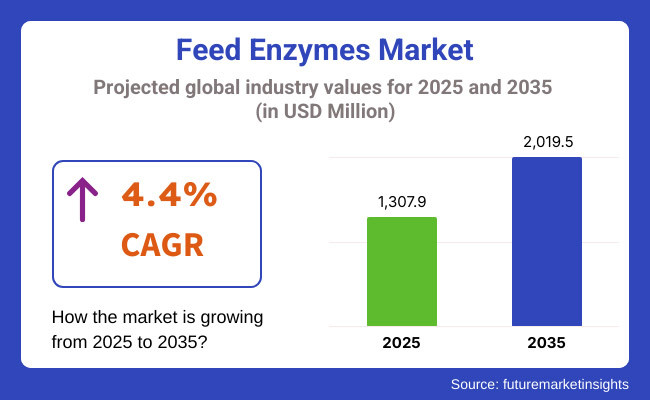 Microscopic proteins added to livestock diets are now seen as critical to making animal agriculture faster, cleaner, and cheaper. From poultry to swine to cattle, enzymes are helping animals digest nutrients more efficiently, grow faster, and leave behind less environmental waste. The global market is surging — and that should be a wake-up call, not a victory lap.
Microscopic proteins added to livestock diets are now seen as critical to making animal agriculture faster, cleaner, and cheaper. From poultry to swine to cattle, enzymes are helping animals digest nutrients more efficiently, grow faster, and leave behind less environmental waste. The global market is surging — and that should be a wake-up call, not a victory lap.
According to Future Market Insights, the global feed enzyme market is poised to grow from USD 1.3 billion in 2025 to nearly USD 2.0 billion by 2035, with a compound annual growth rate of 4.4%. That’s not a bump. That’s a reshaping of modern livestock production.
But as the science accelerates, U.S. regulatory attention remains sluggish — and that silence is starting to sound dangerous.
Explore Emerging Market Insights: Request a Sample Report Now: https://www.futuremarketinsights.com/reports/sample/rep-gb-6366
Enzymes Are Not Just Additives Anymore
Gone are the days when feed additives were about tossing in some minerals and protein powder. Today’s enzyme blends — including phytase, protease, amylase, and cellulase — are precision tools. They unlock nutrients hidden in fiber, reduce feed waste, lower methane output, and minimize the need for antibiotics.
In theory, it’s a win across the board. Less cost for farmers. Less pollution. Faster growth. And fewer drugs in our meat. What’s not to love?
The problem: these enzymes are increasingly complex. Some are derived from genetically modified microorganisms. Others are formulated with synthetic biology. They’re not just breaking down starch — they’re replacing long-standing feed ingredients and reshaping animal metabolism. That deserves oversight. We’re not getting it.
High Demand for Market Insights: Discover Comprehensive Trends in Our Full Report: https://www.futuremarketinsights.com/reports/feed-enzymes-market
Regulation Hasn’t Kept Up. That’s a Problem.
Despite the explosive market growth, there is no unified regulatory framework in the U.S. specifically tailored to feed enzymes. These products fall through the cracks of existing animal-feed and food-safety systems.
That means manufacturers are often left to conduct their own safety evaluations — and regulators often rubber-stamp those claims. There are no mandatory transparency rules, no standard testing protocols, and no requirement for long-term environmental or animal-health impact studies.
Meanwhile, the enzyme market marches on — bolstered by investor optimism and biotechnology advancements. According to FMI, demand is highest in the poultry segment, but applications across aquaculture and ruminant livestock are accelerating. The North American market alone accounts for nearly one-fifth of the global share.
This isn’t a fringe innovation. It’s now foundational. And yet, we treat it like a food-coloring decision.
The Stakes Are Bigger Than They Look
When we don’t regulate what goes into the animals that feed us, we end up regulating nothing at all.
The lack of standardization for enzyme blends means one poultry farmer’s feed could differ dramatically from another’s — even if both claim the same benefits. Animals become test subjects. Consumers remain in the dark. And corporations get to race ahead without accountability.
If feed enzymes are going to shape the future of sustainable animal protein, then the burden can’t fall on biotech firms to self-police. We need national policy. We need inspection standards. We need mandatory disclosures on enzyme origins, performance, and safety.
Because when the market hits $1.8 billion — and make no mistake, it will — it shouldn’t be a biotech free-for-all. It should be a milestone in science-backed, ethically governed agriculture.
Bottom Line
The feed enzyme market is booming, and the science behind it is exciting. But growth without guardrails doesn’t make food safer — it just makes risk invisible.
Regulators need to wake up. This isn’t just about profit. It’s about what we feed the world. And right now, too much of it is happening in the shadows.
Leading Feed Enzymes Brands
- BASF SE
- DuPont
- Associated British Foods Plc
- BEHN MEYER
- DSM
- Azelis S.A.
- Rossari
- BIO-CAT
- BEC Feed Solutions
- Adisseo
- Bioproton Pty Ltd.
- Novus International
- BioResource International, Inc.,
- Alltech
- Lesaffre
- Karyotica Biologicals Pvt Ltd.
- Aum Enzymes
- Biovet
- Chr. Hansen Holding A/S
- CapriEnzymes
- Advanced Enzyme Technologies
- Enzyme Innovation Lumis
- VEMO 99 Ltd.
- Novozymes
- Others
 Explore Animal Nutrition Industry Analysis: https://www.futuremarketinsights.com/industry-analysis/animal-nutrition
Explore Animal Nutrition Industry Analysis: https://www.futuremarketinsights.com/industry-analysis/animal-nutrition
Feed Enzymes Market Segmentation
By Form:
This segment is further categorized into Dry and Liquid.
By Product:
This segment is further categorized into Phytase, Carbohydrase, Protease.
By Source:
This segment is further categorized into Microorganisms, Plants, and Animals.
By Animal:
This segment is further categorized into Poultry, Ruminants, Swine, Aquatic Animals, and Others (Equine & Pets).
By Region:
Industry analysis has been carried out in key countries of North America, Latin America, Eastern Europe, Western Europe, East Asia, South Asia & Pacific, Central Asia, Balkan and Baltic Countries, Russia & Belarus and the Middle East & Africa.


